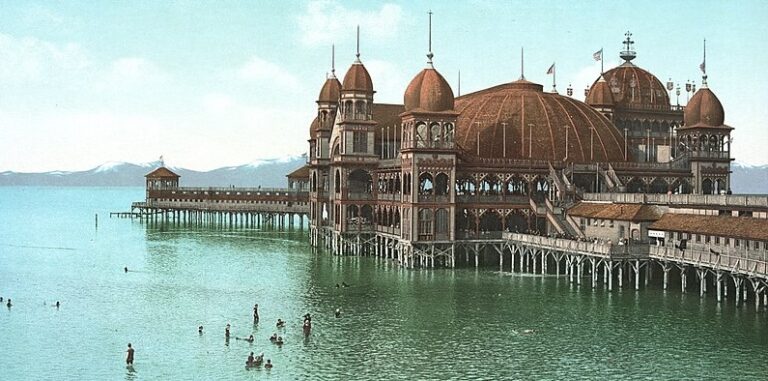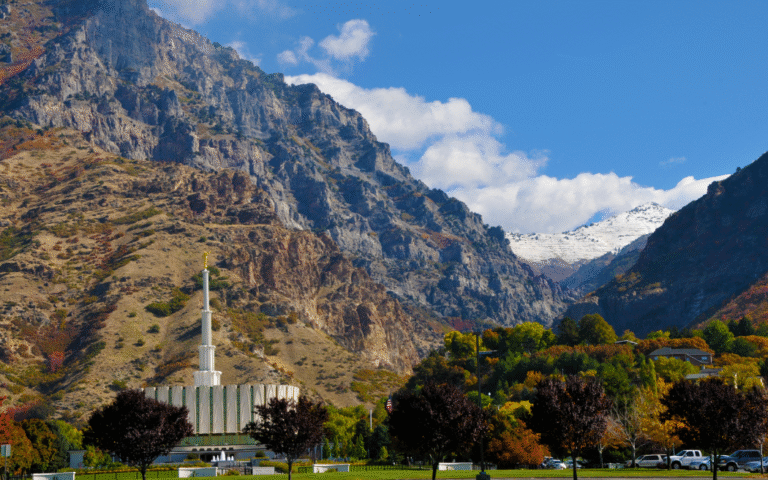The Art of Letting Go: A Latter-day Saint Reflection on Great Salt Lake
By Becky Wilson
Wonder and Loss
When Wilford Woodruff first arrived in Salt Lake Valley, piercing-blue eyes taking in mountains sharp as pyramids, freshwater streams criss-crossing the valley floor, and a vast inland sea so salty he could hold its crystals in his hands, he wrote in his journal:
“We gazed with wonder and admiration upon… a large lake of salt water of miles in extent… creeks, brooks and rivers of various sizes all of which… wend[ed] their way into the great salt lake; our hearts were surely made glad…”
Nearly two centuries later, my heart too has been made glad from wonder and admiration for Great Salt Lake as I have watched bulrush shake in the wind and light dance upon the face of its waters.
My grandpa George Wilson mentions “dancing at the Rainbow Lagoon, or Saltair,” a once tantalizing resort and amusement park on Great Salt Lake’s shores in his journal. I imagine those dances offered a treasured reprieve from his Depression-era teenage years. I picture him dancing with Ida Van Cott, the moonlight-haired, twinkling-eyed woman who would later feed me peaches from a can: my grandmother.

From the wonder of early Saints to the joy of my own ancestors dancing by its shores, Great Salt Lake has long been a place of beauty and reprieve. Today, its future hangs in balance as human-driven water diversions have shrunk the lake dramatically and exposed more than 1,000 miles of lakebed.
In this context, in addition to pressing environmental issues around the world, I am humbled to join you in seeking to understand our right relationship with the earth. Though I am still trying to understand this relationship, the role of letting go of what no longer serves presses upon my mind.
Letting Go as Stewardship
Doctrine and Covenants 136 commands the Saints journeying West to “be diligent in preserving what thou hast, that thou mayest be a wise steward; for it is the free gift of the Lord thy God and thou art his steward” (Doctrine and Covenants 136:27).
I am inspired by many early Latter-day Saint efforts to practice wise stewardship as they exchanged with their neighbors and kept excess food in storehouses for those in need. Brigham Young interpreted wise stewardship of Salt Lake Valley as putting all water to beneficial use. This water irrigation diverted rivers from Great Salt Lake and allowed for the production of crops and construction of temples. Now, however, it is clear that continued extensive water diversions will hinder the same purposes and fail to preserve Great Salt Lake.
The Church of Jesus Christ of Latter-day Saints has committed to be a part of the lake’s solution. They have made two of the largest water donations to the lake, one of which relinquished enough water shares to return 20,000 acre-feet of water annually to Great Salt Lake’s thirsty shores.
Their act exemplifies that wise stewardship of the earth, much like relinquishing water shares, often entails letting go of consumptive practices or perceived ownership. Perhaps this is the essence of repentance–not only forsaking sin, but releasing what no longer serves life.
The Apartment Purge
Two weeks before my second semester of a master’s program that has been more spiritually and emotionally exhausting than I anticipated, I landed upon “The Life-Changing Magic of Tidying Up: The Japanese Art of Decluttering and Organizing” by Marie Kondo.
Kondo suggests that all of our possessions exist for our benefit. “Everything you own wants to be of use to you,” she says (192). With this in mind, I handled, sorted, and donated my belongings, choosing to let go of items I realized no longer served me. Appreciating the role those objects played in my past helped me give them up. Our little flat – with green onions on the windowsill and my favorite books brilliantly greeting me on a shelf – became an oasis of safety, a refuge where I assume that I am loved on all sides.
Letting go – honoring the past and releasing what no longer brings life – naturally gave way to a greater care of my belongings. It also, perhaps, prepared me to see the earth as living, loving, and deserving of the same decluttering and tidying up.
The Rain
One day while at the Missionary Training Center, my companions and I walked to a field bordering the Provo North Temple. Wind rattled the trees and burling rain clouds gathered in a navy sky. In a moment’s notice, rain began to pour. Finding the field closed, we laughed for exhilaration and turned around, rain dripping from our ponytails.

That night, I sat criss-cross applesauce on my bed, seeking divine connection.
“Heavenly Father,” I prayed, “How was your day today?”
As I let my imagination run, I pictured God telling me that He and Heavenly Mother spent most of their day cultivating good on earth. In a string of thoughts, I also pictured God saying They tried to do the same for me.
“We blessed you this morning with that cloudy, rainy weather, and we blessed you to walk to the field and experience the beauty of it. This morning was a gift for you, weather and all.”
In that moment, I felt love from God and from the rain. The rain was for me – and for the elm tree down the street. The lake, too, is for me, and for the millions of birds who depend on it.
Love and Collective Repentance
We are equipped to let go when we first feel how loved we are. Repentance relies on the internal love to see sin, weakness, and suffering, seek help, and believe in the possibility for change. It relies on external love to grant mercy, forgiveness, and grace. This love is etched into pierced hands and flooded into springs of everlasting water.
I see God’s love in Great Salt Lake. The lake gives and gives – increasing snowfall, moderating the climate, offering minerals, supporting global industries. It is my hope that you feel this love too.
The first counselor in the presiding Bishopric, Christopher N. Waddell has called, “we invite members of the Church and community to reduce their consumption. We encourage engagement and responsiveness to legislative changes and other recommendations from subject matter experts recognizing the need to act with urgency and unity towards the future we hope for – one with a healthy Great Salt Lake.”
It is also my hope that we respond to Bishop Waddell’s call and turn this love in acts of collective release. Subject matter experts overwhelmingly recommend water conservation, not reengineering nature to meet our needs. These acts include letting go of water-intensive lawns, reducing water-intensive crops, and letting go of unsustainable policies. Nonprofit groups like Grow the Flow Utah and statewide initiatives like Slow the Flow offer support and unify efforts. When wrapped in love, these efforts always carry the hope of new life.
Becky Wilson was born in Wisconsin and grew up in California. Currently, she is a Master’s of Divinity candidate at Harvard Divinity School.
